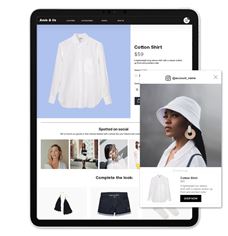[ad_1]
61% of US and UK consumers say seeing visual user-generated content (UGC) from other customers can reduce the growing number of fashion ecommerce returns which is hitting retailers’ profitability and sustainability goals. And around half of consumers now accept that returning online fashion purchases is bad for the environment
NEW YORK and LONDON (July 14, 2022) – 61%[1] of consumers questioned in a new poll think fashion retailers can cut rapidly rising ecommerce product return rates by including more post-purchase photos and videos from other customers—to help shoppers see how clothes look on ‘real’ people, not just models. 59% say virtual try-on tech that allows shoppers to picture themselves in outfits they find online will also help to rein back returns.

Retailers can cut ecommerce product returns by including more post-purchase photos and videos from other customers
The findings come from a survey of just over 2,000 US and UK consumers commissioned by Nosto, the Commerce Experience Platform, which is used by fashion brands such as Patagonia, Paul Smith, Pangaia, and Todd Snyder.
The new research coincides with rising returns volumes reportedly hurting the profitability of online fashion brands such as ASOS and Boohoo. In the US, average ecommerce return rates jumped to 20.8% in 2021 with an estimated $671 billion worth of goods being returned.
Escalating ecommerce returns reduce profits by hiking up retailers’ delivery and warehousing spend (increasing costs by as much as 21% of a product’s order value). And there’s also the problem that returned inventory negatively impacts the environment, with annual carbon dioxide emissions from transporting returned goods in the US estimated to equate to having 3 million more cars on the road.
Fashion retail brands are also increasingly conscious that performing poorly on sustainability and protecting the environment can damage their credibility. Recently, several brands including H&M stopped using a tool that tries to measure the sustainability of garments over concerns about greenwashing.
Importantly, respondents to Nosto’s survey were more than twice as likely to agree that returns are bad for the environment than disagree (49% v 17%[2]) on the basis that returns waste fuel, packaging and other resources.
“Polished, studio imagery has been the default way to show clothes off on ecommerce stores. But supplementing this with customers’ own imagery gives shoppers a more accurate reflection of how products are worn in everyday situations, and by ‘everyday people’ who also own the items,” says Damien Mahoney, Chief Strategy Officer of Nosto.
“That’s why fashion retailers are leveraging customers’ visual UGC on their websites, such as the post-purchase selfies they encourage customers to share on Instagram. The savviest retailers are also encouraging their customers to comment on the likes of products’ fit or share their measurements within captions, so others can make comparisons that better inform purchase decisions and therefore lessen returns.”
Separate research conducted last year by Stackla, the visual UGC platform (now a part of Nosto) indicates that consumers are very happy to let fashion retailers use their post purchase selfies – 58% would give permission to a brand to use images of their fashion purchases as part of their marketing.
Alongside using more UGC, nearly half (49%) of consumers questioned in Nosto’s survey agreed that charging customers for returns—or stopping free returns, as Zara has started doing recently—can stem the flow of products fashion shoppers send back by making them think more carefully about whether they’re going to keep a product before they place an order.
And the research suggests that retailers must continue to pay close attention to some of the more basic tactics to help keep returns down. This includes taking steps to ensure online information is clear, accurate and detailed (66%), orders are not damaged before being sent and that correct items are packed (also 66%).
Read more insights from Nosto’s research on the company blog article. These are the initial findings from a broader survey on consumer attitudes to sustainability in fashion retail which will be released by Nosto later in 2022.
[1] Respondents were asked if they Strongly agree, Somewhat agree, Neither agree nor disagree, Somewhat disagree, Strongly disagree with a list of statements. Almost throughout the press release ‘Strongly agree’ and ‘Somewhat agree’ answers have been added together when referring to results.
[2] Combining 17% of respondents who answered ‘Somewhat disagree’ or ‘Strongly disagree’ to the following: I believe that returning fashion products purchased online is bad for the environment because it uses up fuel, packaging and other resources
[Ends]
About the research
Nosto commissioned international market research consultancy Censuswide to conduct an online survey of 2,019 consumers (1,002 in the US and 1,017 in the UK, both samples national representative based on age, gender and region). The survey was conducted between 13 June and 16 June, 2022. Censuswide abides by and employs members of the Market Research Society which is based on the ESOMAR principles.
About Nosto
Nosto enables online brands to deliver authentic, relevant, and personalized experiences at every touchpoint, across every device. An AI-Powered Commerce Experience Platform (CXP) designed for ease of use, Nosto empowers brands to build, launch, and optimize compelling digital experiences without the need for dedicated IT resources or a lengthy implementation process. Leading brands in over 100 countries use Nosto to grow their business and delight their customers. Nosto supports its clients from its offices in New York, Los Angeles, London, Paris, Berlin, Stockholm and Helsinki.
Contact
UK/EU/ROW: Uday Radia, CloudNinePR
uradio@cloudninepr.com
North America: John Forberger, Forberger Communications
john@johnferberger.com
[ad_2]
Source link
